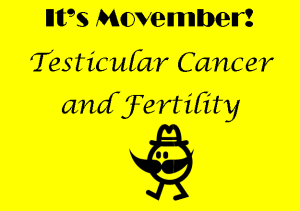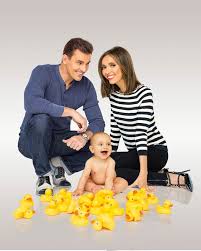 Infertility is hard enough without dealing with the added stress of cancer.
Infertility is hard enough without dealing with the added stress of cancer.
Movember is the month dedicated to testicular cancer.
I thought, in honour of this month, we’d take a look at some celebrities who have battled cancer and still managed to have children.
1) Scott Hamilton, figure skating champion, battled testicular cancer and had two kids.
Scott reveals, “The fact that Aidan was born nine months and two days after Tracie and I were married was a shock. I was fortunate that the cancer and the chemo didn’t affect my ability to father a child.”
His second child was more of a problem, however. Scott had a tumour on his pituitary gland and had to have injections for testosterone.
He boasts that his two boys “are the best thing that has ever happened to me. Both boys are miracles, considering my medical history.”
2) Before Lance Armstrong became a disgraced cyclist, he was a testicular cancer survivor.
Lance used sperm he had banked before chemotherapy to conceive children via IVF. He also conceived naturally ten years after it.
Cancer survivors had mixed responses to his admitting cheating during his cycling career.
Cnn user “jackiero” says: “As an avid cyclist and a cancer survivor who used cycling to aid in my recovery, I am disgusted by this man,” jackiero wrote. “I threw away all my (Livestrong) gear not because I don’t support the cure — of course I do — but because I support the cure without the taint of a cheater like Armstrong. He was an inspiration until I learned that he was just like all the other chemically induced sports stars who rake in millions and millions.”
Armstrong’s cheating in cycling also hasn’t tarnished his image as a source of inspiration for Amy Wadsworth, who found out she had breast cancer at age 29.
She feels grateful for all that Armstrong has done for the cancer community, and appreciates that Livestrong had offered to help her pay for egg preservation because cancer and treatment for it could have impaired her fertility.
“I think we should accept his apology and move (on)because what he has done to help people with cancer definitely out weighs the ‘bad.’ He didn’t give up when he was (stared) in the face with cancer,” Wadsworth said of Armstrong. “He kept going and encouraged many other survivors to the same.”
3) Guilana Rancic is my personal inspiration. (Ok I know she had breast cancer, not testicular cancer, but I have to add her in). Guilana underwent a few IVFs and on the last one discovered she had breast cancer. She basically had to stop her IVF cycle at the point of retrieving the embryos and go for cancer treatment. One of these embryos was given to a gestational carrier and her child, Duke, was born.
At the time of her diagnosis Guilana earned my respect by acknowledging some greater design in her life of this disease and the timing of the baby: “I’m not gonna give up, I want that baby. And what’s amazing is that baby will have saved my life…Now I truly believe that God was looking out for me. Had I gotten pregnant [earlier], a few years down the line I could be a lot sicker.”
More information on testicular cancer and fertility:
-Testicular cancer is the most common cancer among men aged 20-34.
-Chemotherapy is a huge risk to fertility, but research shows that still 70% are still able to father children.
– If treatment does cause permanent infertility you need to have the opportunity of sperm banking before starting treatment.
– Sometimes the lymph glands in your abdomen need to be surgically removed, especially if they are still enlarged after radiotherapy or chemotherapy. This can affect your fertility because the operation can cause retrograde ejacularion. New techniques in surgery are helping to reduce this problem. It also has no effect on erections or orgasms.
-Chemotherapy may cause temporary infertility in most cases. With high doses, it may even not recover.
-The best thing you can do is see a recommended fertility specialist and have your fertility tested. This is one thing I regret about my own fertility journey, that I wasted time with gynaes instead of going to Medfem earlier. The experts can give you options.
-One thing I did do right was take lots of supplements. (You can read the post about vitamins I took for fertility here).
 -Men can take Prelox. You can also do this prior to sperm banking.
-Men can take Prelox. You can also do this prior to sperm banking.
Benefits of Prelox include:
1) Increase in the anti oxidative capacity of plasma
2) Stimulates the activity of e-NOS (endothelial nitric oxide synthetase)
3) In combination with L-arginine Prelox increases e-NOS in spermatozoa.
4) An increase in spermatozoa NO (Nitric Oxide) increases sperm motility and human sperm capacitance.
– Be safe. Bank your sperm if you are about to have chemo. If your sperm is suitable you need to give 2 or 3 samples over a period of a few days. The samples are frozen and stored until you are 55. If you need them for future fertility treatments, they can be thawed and used. You should have the option of counselling at the fertility clinic. A consent form will be signed. Blood tests can rule out any illnesses or infections such as HIV or hepatitis.
-On the other hand if your cancer is so life threatening that treatment needs to begin immediately, you may not have the option to delay it by sperm banking.
-Of course, like all infertility treatments, there are no guarantees, and that is the harsh reality of it. Some sperm will die when the sample is thawed. IVF doesn’t always work the first time. This makes it even more important to have a high quality sperm sample.
For further information on Prelox, please visit www.2tostartafamily.co.za
This post was sponsored by Prelox through MyScoop.



[…] November was also Movember, for testicular cancer. I wrote about it here. […]